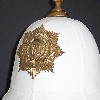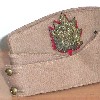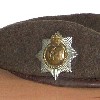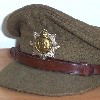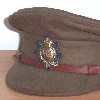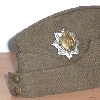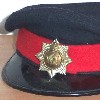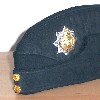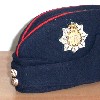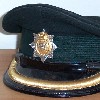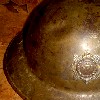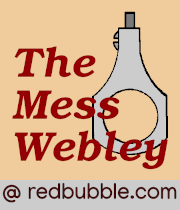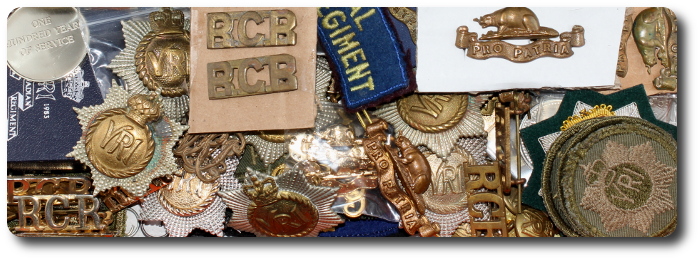
Badges of The Royal Canadian Regiment
Headdress
1899
Puggaree
Regimental Orders Book:- Order No. 116, para 3, dated 3 October 1899, and signed by Lt Col W.D. Otter
3. The Major General Commanding considers that the addition of a narrow puggaree would be a great improvement to the appearance of the helmet. This point should be considered and a pattern submitted by the Commanding Officer for his approval."
1901
Puggaree (Officers)
Regimental Orders Book:- Order No. 167, para 2, dated 22 May 1901, signed by Lt Col L. Buchan
"Officers will wear a silk Puggaree of Regimental Colours in eight folds on their helmet. Those of the approved pattern may be obtained from Hawkes & Co."
1906
Puggarees
General Order 47, April 1906
"A puggaree will be issued to all recruits belonging to units authorized to wear it.
1906
Puggarees
General Order 114; July 1906
"Permission is given to all units of the permanent force to wear puggarees with helmets. The badge to be the same as worn on the cloth field service cap, except' where a special badge has been authorized. A puggaree will be issued to each non-commissioned officer and man now serving, and to recruits when issued with helmet. Subsequent issues to be made on repayment."
1907
Canadian Militia Dress Regulations 1907
Royal Canadian Regiment.
197. Helmet. -- Universal pattern. See paragraph 14.
14. Helmet. -- Cork covered with white cloth in six seams, bound with buff leather at the bottom; above the peak and going round the helmet a buff leather band one inch wide, stitched at top and bottom. The head piece let in with zigzag ventilator; back peak to centre of crown 12 inches; front peak to centre of crown 10 3/4 in., side to centre of crown 9 inches; side hooks, curb chain, the links 1 inch wide; the chain lined with white leather. At the top of helmet a collet, riveted on to a collar 1 inch wide, to receive spike and base. A hook at the side to which the chain is attached when not required to be worn under the chin. Rifle regiments will have a chin chain on morocco leather of the same colour as the regimental facings, lined with black velvet. A leather chin strap 1 inch broad is worn in all Orders of dress except Review Order.
Ornaments as follows, --
Engineers, Infantry, and Ordnance Stores Corps, except officers serving on the staff. -- Spike of bright metal mounted on a bright dome base.
Dimensions. -- Height of spike from place of insertion in dome is 2 3/4 inches.
Total height of spike and dome 3 1/4 inches.
Diameter of spike at point of contact with dome 1 inch.
Diameter of dome 1 7/8 inch full.
Circumference of dome at point of contact with helmet 5 7/8 inches.
199. Puggaree. -- White. Vide paragraph 15.
15. Puggarees. -- If worn to be white, (unless otherwise authorized) ; it is not to be worn with the helmet plate: If a badge is worn it is to be similar in design to the field cap badge authorised, and must be so fitted as not to perforate either the puggaree or helmet plate.
210. Fur Cap. -- Unplucked Otter (folded in a manner similar to Glengarry), 7 inches high, wedge shaped.
1908
General Order 136, June 1908
Caps Naval pattern (N.P.), Khaki - This order states, in part, that a cap, naval pattern khaki has been approved for issue to the Permanent Corps, and a first issue will be made to al ranks, excepting officers to count from 1st July.
H.Q. 96-9-19
1910
MILITIA ORDERS; Saturday, 9th July, 1910
Dress Regulations: Use of "Wolseley" Helmet. -- Pending the publication of a General Order amending paragraph 14, Dress Regulations for the Canadian Militia, 1907, it is notified for the information of all concerned that the "Wolseley Helmet" is to be adopted for use by the permanent force.
Officers of the permanent force will govern themselves accordingly.
1912
General Order 2, January 1912
Amendement to Dress Regulations 1907
"Para 14, cancel from "Cork" in line 1, to "chin" in line 6, and insert:-
"Wolseley pattern, cork, covered with white cloth, made with six seams, bound with buff leather, projecting peak all round, 3 inches in front, 4 inches in back, and 2 inches at sides, ventilated at top with white cloth, side hooks. At top of helmet a collet riveted on to a collar 3/8 inch wide to receive button."
1914
General Order 53, April 1914
A scarlet puggaree is authorized for The Royal Canadian Regiment
1926
General Order 48, June 1926
Amendment to Dress Regulation 1907
"3. Para 210. Add the following sentence:- "A Royal Blue Cloth Bag is worn at the left side of the cap with cap badge at the bottom of the bag."
1930
General Order 49, April 1930
Winter Caps and Gauntletsl. A winter cap of the same pattern as worn by other ranks but made of unplucked beaver and drab cloth to match the colour of the drab greatcoat, and gauntlets of the same pattern as the Persian Lamb gauntlets but made of unplucked beaver, with brown leather palms, are hereby authorized for all officers of the Permanent Active Militia with effect from 1st April, 1930.
2. In the case of the Royal Canadian Regiment the fur may be unplucked otter instead of beaver.
3. The wedge shaped caps and gauntlets authorized by existing regulations may be continued in wear until 1st January, 1936, but all caps and gauntlets purchased in future will be of the pattern described in para 1.
4. Detailed specifications of the cap and gauntlets referred to in para 1, will be published at an early date.
5. The provision of winter caps and gauntlets by officers of the Non-Permanent Active Militia is optional.
6. Dress Regulations for the Canadian Militia, 1907, will be amended accordingly on revision.
H.Q. 305-3-47
M.N.D.
1937
Field Service Cap
On the 19th November, 1937, a recommendation was made, after consulting the serving officers of the Regiment, for permission to re-adopt the wearing of the Field Service Cap.
Authority was received on the 6th December, 1937 (L.12-3-18) to adopt the cap of the pattern recommended namely, blue cap, blue crown and scarlet piping on crown front and back seams.
The caps were procured from Edward Smith, 25, Cork St., Bond St., London, England.
1946
Canadian Army Routine Orders, No. 6868
6th December, 1946
Appendix I to Routine Order No. 6868; Dress Regulations for Officers and Other Ranks of the Canadian Army (Provisional) 1946
8. Headdress to be worn. with
Battle Dress:- ,
(a) On parade with troops the Beret, 'Balmoral, Tam
O'Shanter or Irish Bonnet as authorized for the Corps or Unit concerned.
Colonels, and above may wear the Drab Service Peak Cap. Coloured Field Service
Caps will not be worn.
(b) On duty-Same as (a) except that the Drab Service
Peak Cap may be optional for all Officers and Warrant Officers.
(c) Off duty-Same as (b) except that the coloured Field
Service Cap or Glengarry as appropriate may be worn.
(d) Dress Highland, Scottish, and Irish Regiments for
special occasions see "Service Dress Section".
Appendix II to Routine Order No. 6868; Dress Regulations for Officers and Other Ranks of the Canadian Army (Provisional) 1946
3. Headdress which may be worn with Service Dress are as follows:
(a) Colonels and above:
(i) Drab Service Peak Cap or,
(ii) If formerly belonging to a Regiment or Corps which wears a distinctive headdress, such headdress may be worn at the discretion of the Officer.
(iii) Coloured Cap Field Service may be worn off duty.
(b) Officers below the rank of Colonel:
(i) Drab Service Peak Cap.
(ii) Undress Forage Cap - for Officers Gf Governor Generals Horse Guards and Foot Guards.
(iii) Beret Black - Officers of Royal Canadian Armoured Corps.
(iv) Irish Bonnet - Officers of Irish Regiment of Canada.
(v) Balmoral or Glengarry-Officers of Highland and Scottish Units.
(vi) Beret Airborne - Airborne Officers.
(vii) Beret Khaki - All other officers wear the same pattern as worn by other ranks.
(viii) Coloured field service cap as appropriate to the Unit or Corps concerned when off duty.
1947
The Royal Canadian Regiment
Dress Regulations, 1947
GENERAL
1. Headdress (Berets)
Issue beret will be worn. On the beret the badge will be worn so that the lower tip of the star is 1/4 of an inch above the bottom of the band of the beret. A cardboard stiffener 2 inches square will be placed inside the beret behind the badge to hold the badge in place correctly. Creases will NOT be pressed in the beret nor will wires be placed in it as shapers. Beret will be worn with the badge above the left eye, band of the beret to be straight across the forehead and one inch above the eyebrows. The loose portion of the beret will be pulled over and down to the right rear.
2. Caps Winter Melton
When ordered caps winter melton will be worn. The cap will be worn squarely on the head with a single crease down the centre. The front brim one inch above the eyebrows. The cap badge will be worn in the centre of the front visor. No cardboard or other material will be placed in the brim nor will the cap be defaced in any manner. The ear flaps when NOT worn down over the ears will be tied up with flat double bow in the centre of the crease.
OFFICERS DRESS
1. Headdress
Caps forage NP of the regimental pattern in English melton cloth will be worn by all officers on duty or parade, with the exception that caps beret, officers' pattern, will be worn on ceremonial parades.
- The O'Leary Collection; Medals of The Royal Canadian Regiment.
- Researching Canadian Soldiers of the First World War
- Researching The Royal Canadian Regiment
- The RCR in the First World War
- Badges of The RCR
- The Senior Subaltern
- The Minute Book (blog)
- Rogue Papers
- Tactical Primers
- The Regimental Library
- Battle Honours
- Perpetuation of the CEF
- A Miscellany
- Quotes
- The Frontenac Times
- Site Map
QUICK LINKS
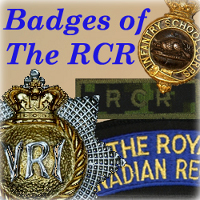
1. Introduction
2. Crowns, Cyphers and Controversy
3. Rare and Unusual Regimental Badges
4. Shoulder Flashes and Titles
1883
1894-1902, 1919-27
South African War
EviiR Badges (1902-11)
GvR Badges (1911-19)
St Edward's Crowns (1927-70s)
Maj Cock, M.C., Collection (1933)
Imperial Crowns (1926-50s)
Imperial Crowns (1960s-80s)
Dress Regs - 1960
Dress Regs - 1967
1980s
1990s
2000+
Woven Badges
Blazer Badges
Pipers' Badges
Belt Buckles
Miscellaneous
Crowns, Cyphers and Stars
RCR Headdress
Badged Brodies
Badge References
